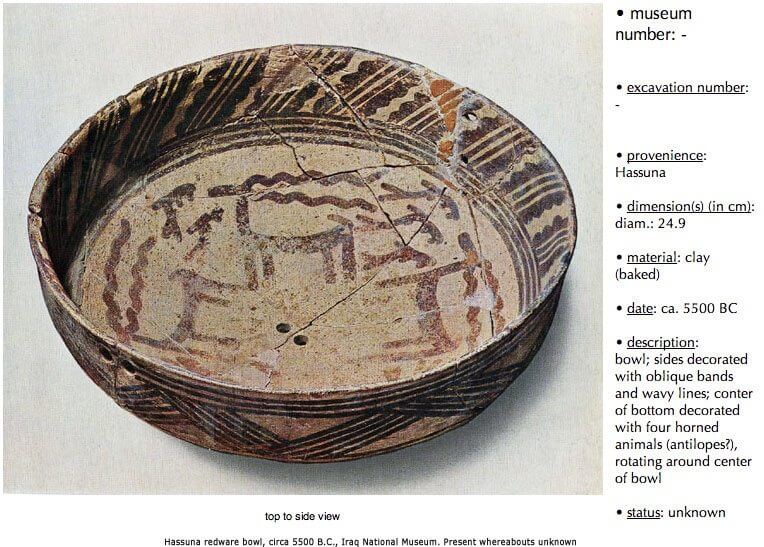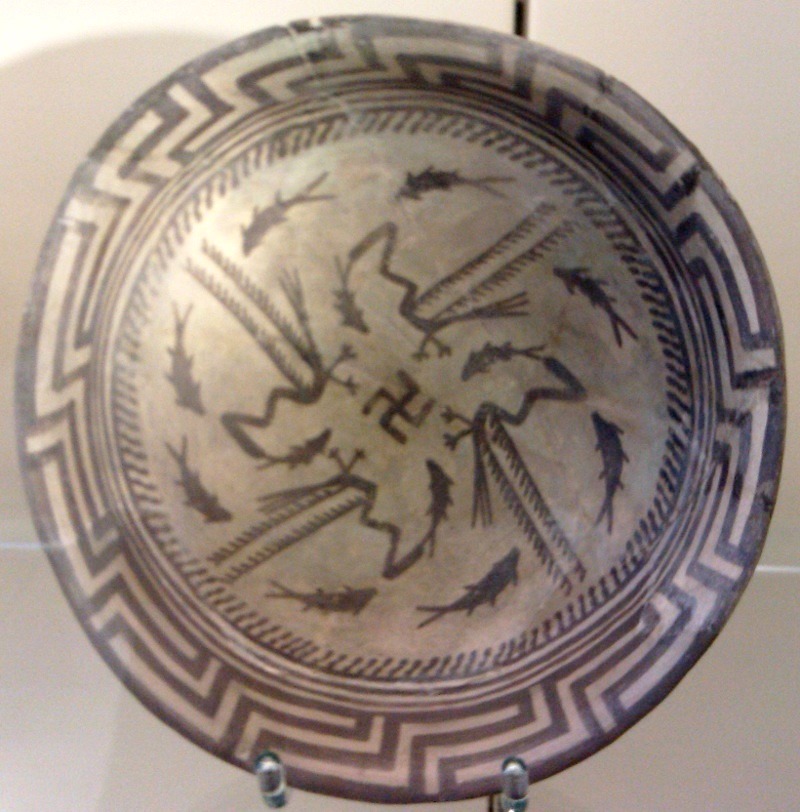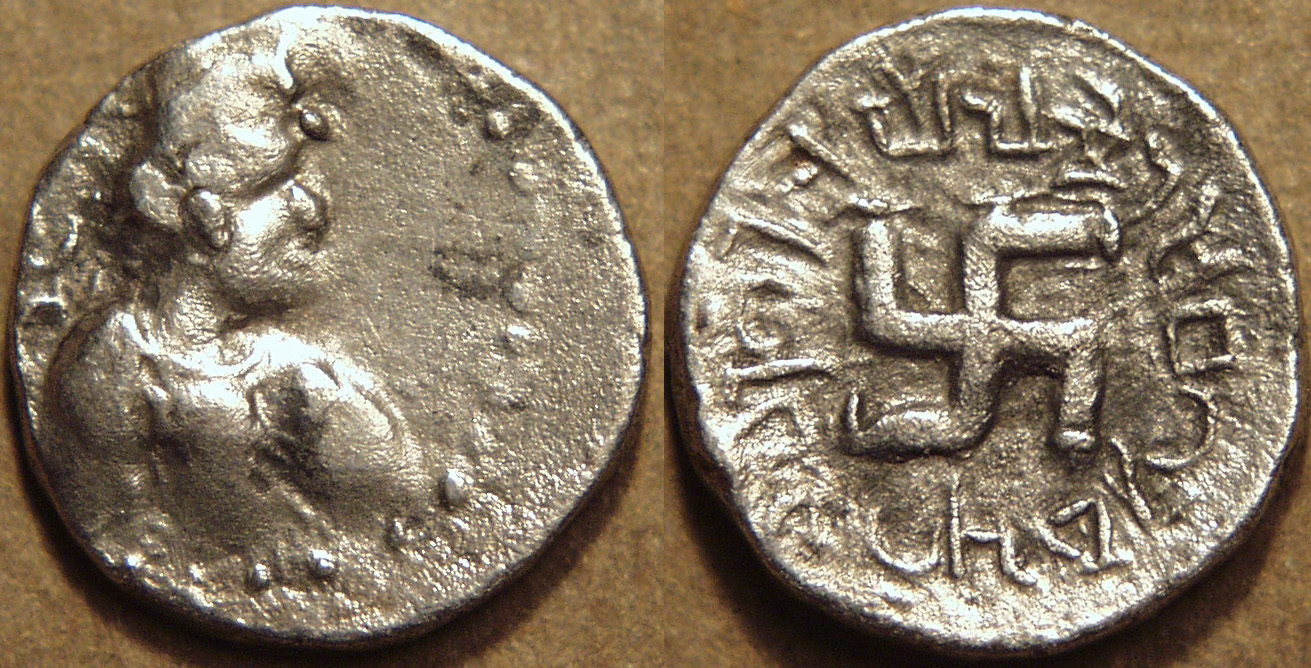swastika - pannous/hieros GitHub Wiki
Name of the swastika in Asia:
WÀN 卍
MAN 卐 Manji
The now infamous Swastika symbol is a sad witness for how facts about the proto-indo-european expandsion where intermingled with nationalist Propaganda.
Unfortunately it is still a good trace marker for early urbanisation:
European hypotheses of the swastika are often treated in conjunction with cross symbols in general, such as the sun cross of pagan Bronze Age religion. The symbol's origin has its certain presence in the "proto-writing" symbol systems, such as the Vinca script, which appeared during the Neolithic:

There are still links missing in the connection of similar Tell Zaidan and Maykop iconography, however
This style clearly developed locally out of Hassuna & Samarra traditions 6000 BC



Samarra bowl (ca. 4000 BC) Mesopotamia
Afterwards it appeared in Sumerian and Harappian civilizations:

Early egyptian circus scenes and pottery show similar style, but it quickly diverged after the first dynasties.
So if one wants to seek directionality from the Danube copper center to the Anatolian copper center at least the transfer must be bidirectional, if not in constant synchronization. The Hamangia culture seems to be one of these synchronizations.
The extreme similarity of both objects above makes a 2000 year time difference very unlikely and acts as a reminder that all prehistoric dating needs to be taken very tentatively.
The division of the skies into 4 quarters is analyzed in cosmolgy and the kur cluster.
Indus valley:

It is one of most common symbols found on Mesopotamian coins (from 500BC?).

Possible relationships of the swastika with the following symbols needs further investigation:
Naga 𒀱 𓃶
aNKhar 𓋹𓈖𓐍 𓃶
naraka=hell! vs Nature 𓇓 𓇑
nagara 𓊖 Kur 𓐍𓂋𓉐
necro 𓊻𓂋𓈉 vs life [𓋹]
nature 𓊹𓊹𓊹𓊹
Eastern asia*
Aryans reached China relatively late:
The spread of the Copper revolution to China can so far only vaguely be traced from the Majiayao 3300 – c. 2000 BC to the Banshan to the Longshan culture 2900-2000 BC down the Yellow River, about 2000 years after copper and copper tools became mainstream in culture(s) adjacent to the Danube.
:max_bytes(150000):strip_icc()/chinesejar-57a91dc75f9b58974a90edfe.jpg)
Majiayao/半山 Bànshān culture, see Erlitou, Xia and Shang dynasties.
Possible etymologic connections of 卍:
卍 swastika from from Sanskrit स्वस्तिक (svastika) = well-being / luck
𓃟 Schwein ⇔ Glück
𓅯𓅬Schwan⇔ schwanen ahnen ⇔ sense 𓅬 guess
𓆂𓅿𓆀𓁷 Svantevit, four-headed god of war and divination in Slavic mythology
𓆄 Swa Shu 𓆅 sWÀN 卍
𓈉 Shan 山 Schanze chance < cadere (fall)
𓊡 𓍢 WÀN 卍 Winde Wende ⇔ 网 wǎng ⇔ 凤 Fèng Phoenix 𓅂 Fang 凡 fán 𓎟 盘 pán = all ⇔ Peter 𓊹
卍 WÀN wander wonder Wender Wunder dreh turn
𓅬 Gunst ⇔ Glück ⇔ Kalika ⇔ 𓎟 @ 𓎡 @ Samarra ☑!?
𓋴 𓏠 𓈖 𓅭 gamnsen(goose) ⇔ 𓋴 GammaDion 卍 ⇔ 𓊹𓇳 ⇔ Summer
𓆂𓅿𓆀𓁷 Svantevit ⇔ 四面神 Simianshen 四卐申占shēn 𓋹单
𓆂𓅿𓆀𓁷 WÀN 卍 Fantian 梵天 佛 fó
𓊹𓊹𓊹𓊹 center 𓏶中重垂車


Boian culture :
Swan-stick @ russia
Swasti ⇔ Su𓊡, west𓊡, vostok𓊡ost !
Schwanenflug Augurs => auspicious (g'lucky) !!
Kalika die vierarmige Glücksfee:

WÀN 卍 PAN 𓎟 vạn all meaning "all" or "eternity" (lit. myriad) Kali ⇔ 𓎟 vs Nirvana
VS Wǔfāng Shàngdì 五方上帝 Five Forms of the Highest Deity 4+1 = whole WÀN => One
完 玩 王 网 福
𓊡𓊹 4 Fahnen ⇔ narba=4!? निर्वाण nirvāṇa ⋍ no wind
𓅂 vạn ⇔ Phoenix 𓅂 凤凤 (see Samarra bowl and wiki)
Kali 𓎟 vs 𓊹 Poly 𓊹𓊹𓊹𓊹 fylfot viel/vier
Hassuna 5400 BC Famous shamanic Wheel of animals Circus as precursor to swastica:

